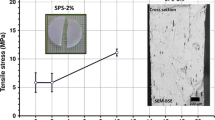Abstract
A 2-Step sinter/anneal treatment has been reported previously for forming porous CPP as biodegradable bone substitutes [9]. During the 2-Step annealing treatment, the heat treatment used strongly affected the rate of CPP degradation in vitro. In the present study, x-ray diffraction and 31P solid state nuclear magnetic resonance were used to determine the phases that formed using different heat treating processes. The effect of in vitro degradation (in PBS at 37 °C, pH 7.1 or 4.5) was also studied. During CPP preparation, β-CPP and γ-CPP were identified in powders formed from a calcium monobasic monohydrate precursor after an initial calcining treatment (10 h at 500 °C). Melting of this CPP powder (at 1100 °C), quenching and grinding formed amorphous CPP powders. Annealing powders at 585 °C (Step-1) resulted in rapid sintering to form amorphous porous CPP. Continued annealing to 650 °C resulted in crystallization to form a multi-phase structure of β-CPP primarily plus lesser amounts of α-CPP, calcium ultra-phosphates and retained amorphous CPP. Annealing above 720 °C and up to 950 °C transformed this to β-CPP phase. In vitro degradation of the 585 °C (Step-1 only) and 650 °C Step-2 annealed multi-phase samples occurred significantly faster than the β-CPP samples formed by Step-2 annealing at or above 720 °C. This faster degradation was attributable to preferential degradation of thermodynamically less stable phases that formed in samples annealed at 650 °C (i.e. α-phase, ultra-phosphate and amorphous CPP). Degradation in lower pH solutions significantly increased degradation rates of the 585 and 650 °C annealed samples but had no significant effect on the β-CPP samples.







Similar content being viewed by others
References
Pilliar RM, Filiaggi MJ, Wells JD, et al. Porous calcium polyphosphate scaffolds for bone substitute applications—in vitro characterization. Biomaterials. 2001;22:963–72.
Grynpas MD, Pilliar RM, Kandel RA, et al. Porous calcium polyphosphate scaffolds for bone substitute applications—in vivo characterization. Biomaterials. 2002;23:2063–70.
Comeau PA, Frei H, Yang C, Fernlund G, Rossi F. In vivo evaluation of calcium polyphosphate for bone regeneration. J Biomater Appl. 2012. doi:10.1177/0885328211401933.
Shanjani Y, Hu Y, Toyserkani E, Grynpas M, Kandel RA, Pilliar RM. Solid freeform fabrication of porous calcium polyphosphate structures for bone substitute applications: in vivo studies. J Biomed Mater Res B. 2013;101:972–80.
Hu Y, Shanjani Y, Toyserkani E, Grynpas M, Wang R, Pilliar R. Porous calcium polyphosphate bone substitutes: additive manufacturing versus conventional gravity sinter processing—Effect on structure and mechanical properties. J Biomed Mater Res B. 2014;102:274–83.
Pilliar R, Kandel R, Grynpas M, Hu Y. Porous calcium polyphosphate as load-bearing bone substitutes: in vivo study. J Biomed Mater Res B. 2013;101:1–8.
Kandel RA, Grynpas M, Pilliar R, Lee J, Waldman S, Zalzal P, Hurtig M. Repair of osteochondral defects with biphasic cartilage-calcium polyphosphate constructs in a sheep model. Biomaterials. 2006;27:4120–31.
Pilliar RM, Kandel RA, Grynpas MD, Theodoropoulos J, Hu Y, Allo B, Changoor A Calcium polyphosphate particulates for bone void filler applications. J Biomed Mater Res B 2016. doi:10.1002/jbm.b.33623.
Pilliar RM, Hong J, Santerre PJ, Method of manufacture of porous inorganic structures, U.S. Patent No. 7494614, 2009.
Filiaggi M, Pilliar RM, Hong J. On the sintering characteristics of calcium polyphosphate. Key Eng Mater. 2001;192–195:171–4.
Ding YL, Chen YW, Qin YJ, Shi GQ, Yu XX, Wan CX. Effect of polymerization degree of calcium polyphosphate on its microstructure and in vitro degradation performance. J Mater Sci Mater Med. 2008;19:1291–5.
Qui K, Zhao XJ, Wan CX, Zhao CS, Chen YW. Effect of strontium ions on the growth of ROS17/2.8 cells on porous calcium polyphosphate scaffolds. Biomaterials. 2006;27:1277–86.
Guo L, Li H. Phase transformations and structure characterization of calcium polyphosphate during sintering. J Mater Sci. 2004;39:7041–7.
Fleisch H, Schubler D, Maerki J, Frissard I. Inhibition of aortic calcification by means of pyrophosphate and polyphosphates. Nature. 1965;207:1300–1.
Francis MD. The inhibition of calcium hydroxyapatite crystal growth by polyphosphonates and polyphosphates. Calcif Tissue Res. 1969;3:151–62.
Omelon SJ, Grynpas MD. Relationship between polyphosphate chemistry, biochemistry and apatite biomineralization. Chem Rev. 2008;108:4694–715.
McIntosh AO, Jablonski WL. X-ray diffraction powder patterns of calcium phosphates Anal. Chem. 1956;28:1424–7.
Hill WL, Faust GT, Reynolds DS. The Binary system P2O5-2CaO·P2O5. Am J Sci. 1944;242:457–77.
Weil M, Puchberger M. Schmedt auf der Günne J, Weber J, Synthesis, crystal structure, and characterization (vibrational and solid-state 31P MAS NMR spectroscopy) of the high-temperature modification of calcium catena-polyphosphate(V). Chem Mater. 2007;19:5067–73.
Pourpoint F, Kolassiba A, Gervais C, Azais T, Bonhomme-Coury L, Bonhomme C, Mauri F. First principles calculations of NMR parameters in biocompatible materials science: the case study of calcium phosphates, β-and γ-Ca(PO3)2 combination with MAS-J experiments. Chem Mater. 2007;19:6367–9.
Witter R, Hartmann P, Vogel J, Jäger C. Measurements of chain length distributions in calcium phosphate glasses using 2D 31P double quantum NMRSolid State. NMR. 1998;13:189–200.
Jäger C, Hartmann P, Witter R, Braun M. New 2D NMR experiments for determining the structure of phosphate glasses: a review. J Non Cryst Solids. 2000;263&264:61–72.
Feike M, Graf R, Schnell I, Jäger C, Spiess HW. Structure of crystalline phosphates from 31P double-quantum NMR spectroscopy. J Am Chem Soc. 1996;118:9631–4.
Griffith E. General phospate chemistry (as applied to fibers). Phosphate fibers. New York: Plenum Press; 1995. p. 57–8.
Acknowledgments
Funding for this study was provided by grants from the Natural Sciences and Engineering Research Council (NSERC) of Canada.
Author information
Authors and Affiliations
Corresponding author
Rights and permissions
About this article
Cite this article
Hu, Y., Pilliar, R., Grynpas, M. et al. Phase transformations during processing and in vitro degradation of porous calcium polyphosphates. J Mater Sci: Mater Med 27, 117 (2016). https://doi.org/10.1007/s10856-016-5725-2
Received:
Accepted:
Published:
DOI: https://doi.org/10.1007/s10856-016-5725-2




